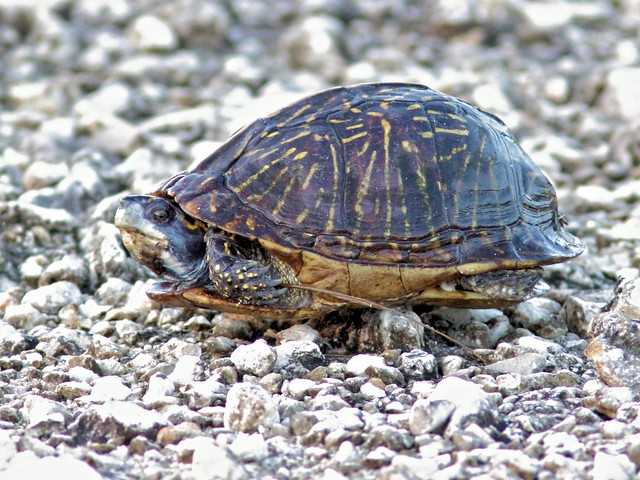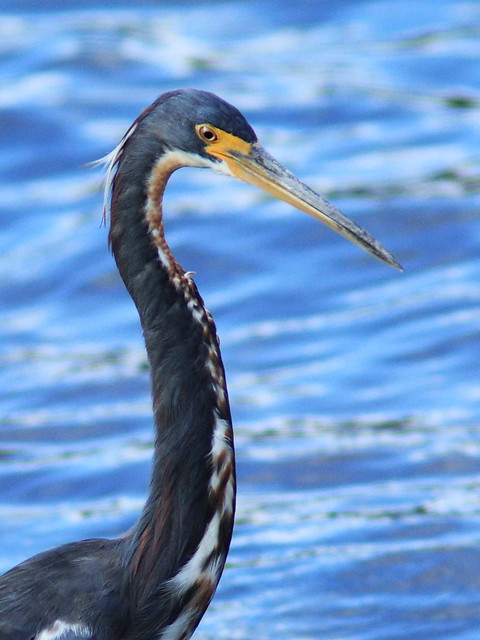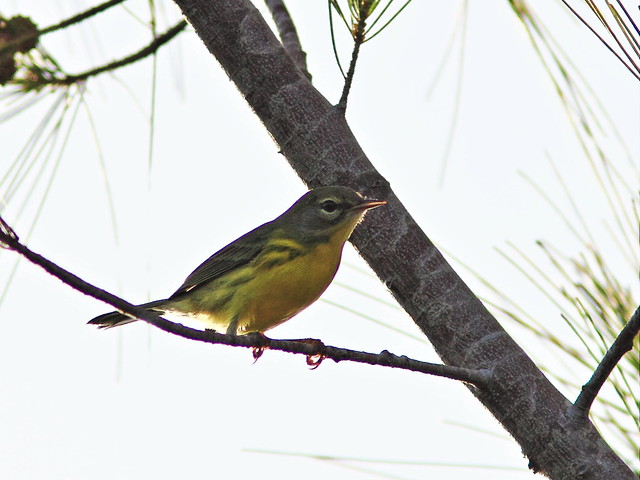Since returning to Florida, we have experienced not only oppressive humidity with temperatures in the mid to high 90s, but record-breaking rainfall. Keeping a wary eye on the clouds, we were able to get out on the wetlands next to our home less frequently during the past three weeks. The typical morning scenario has been storms coming in from the Everglades just west of us, or, as shown in this view of sunrise from our back patio, storms moving in from the ocean front about 18 miles to the east.

One morning, braving the threat of rain, I set out on the gravel road that leads into the wetlands adjacent to our home. I encountered a familiar Florida Box Turtle. Twice before I found him walking across the road in the same direction, away from the wild lands and towards homes where kids would love to capture a new pet. When I returned him to the other side he resolutely turned around to resume his walk in the original direction.

A little ways down. a pair of White-winged Doves marched together in step (well, almost in step).

I had to cut my walk short and got home just as a line of thunderstorms hit. At this point I had about another quarter mile to go. A fine mist was falling out of skies that appeared to be perfectly blue.

We were in the doldrum period as local birds had finished breeding, many were molting, and migrants from the north had not yet arrived.
This Blue Jay appears to have mostly fresh plumage but has not completed its molt around its neck and head. While flight feathers are generally replaced singly or in pairs, it is not unusual for this species to lose whole groups of head and body feathers at one time.

This male Carolina Wren is in heavy molt and appears very shaggy. Molting birds are often rather inactive in order to conserve energy. I thought it unusual that he and a female were singing their duet vigorously as if it were spring.

Yet, the birds came to us! A Great Blue Heron loafed and preened on our back lawn.


A Wood Stork visited almost every day.

Bill partly open, the stork stirred the water with its bright pink feed, frightening small fish and invertebrates into its waiting jaws.

A Tricolored Heron came so close that I could not fit its entire body in the viewfinder.

A White Ibis posed on a street light.

Cattle Egrets flew over.

Out on the wetlands, an immature Tricolored Heron struck a beautiful pose that reminded me of a John James Audubon painting.

The soft beauty of a Great Egret contrasted with the texture of a relict dock on the Harbour Lake impoundment.

The egret was joined by a Little Blue Heron.

The song of the Carolina Wren pierced the quiet of morning.

It is hard to resist the beauty of a Northern Cardinal.

Common Ground-Doves cooed softly.

I was pleased to find as many as three resident Loggerhead Shrikes, as they had been absent all winter and into the spring season.

My first migratory warbler sighting occurred on July 31, a Prairie Warbler. This bird is known to breed in south Florida, but none have been seen locally since spring migration.

A wet and shaggy Marsh Rabbit emerged from the ditch beside the road and almost walked up to me before it realized my presence.

the egrets and herons steal the show! such gorgeous shots, ken!
ReplyDeleteSo many beautiful birds! And I love the sky shots, lovely colors and reflections! Great series, Ken!
ReplyDeleteHI Ken ALL shots are wonderful. The sky photos I love and all the different Herons are excellent. It certainly is a great way to learn about birds from other countries. We only have 1 Heron!!!
ReplyDeleteIncredible series.....I can't even pick a favorite...every picture made me stop and gasp at the beauty! Thank you for showing me what Florida is like when we're not there (and be careful of that lightning!...I'm such a weather wimp, I'd probably be afraid to be out in between showers, so I'd miss all this beauty anyway).
ReplyDeleteYou really got well-acquainted with two very different kinds of heat this year!
Beautiful birds. I like that great blue heron.
ReplyDeleteWhat a terrific series Ken! Your first shot is amazing, terrific reflections. And of course I really enjoyed all your birds.
ReplyDeleteA great series of birds. Your photos are always beautiful but that first one of the early morning and clouds is really exceptional!
ReplyDeleteFabulous post! The first shot is gorgeous.
ReplyDeleteWonderful collection of photos!
ReplyDeleteWonderful shots of a great variety of birds, Ken.
ReplyDelete